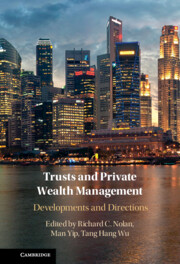Book contents
- Trusts and Private Wealth Management
- Trusts and Private Wealth Management
- Copyright page
- Contents
- Contributors
- Table of Cases
- Table of Legislation
- 1 Introduction
- 2 Family Trusts Today
- Part I The Rise of Asian Wealth
- Part II The Changing Legal Context
- 9 Trusts of Cryptoassets
- 10 Pragmatic Modernisation? Judicial Directions in Trusts and Wealth Management
- 11 Decision-Making in Trusts
- 12 Trustee Decision-Making in the Australian Superannuation Context
- 13 Trusts and UWOs
- 14 Constructive Trusts on Express Trusts
- 15 Abuse of Trust
- Index
10 - Pragmatic Modernisation? Judicial Directions in Trusts and Wealth Management
from Part II - The Changing Legal Context
Published online by Cambridge University Press: 08 December 2022
- Trusts and Private Wealth Management
- Trusts and Private Wealth Management
- Copyright page
- Contents
- Contributors
- Table of Cases
- Table of Legislation
- 1 Introduction
- 2 Family Trusts Today
- Part I The Rise of Asian Wealth
- Part II The Changing Legal Context
- 9 Trusts of Cryptoassets
- 10 Pragmatic Modernisation? Judicial Directions in Trusts and Wealth Management
- 11 Decision-Making in Trusts
- 12 Trustee Decision-Making in the Australian Superannuation Context
- 13 Trusts and UWOs
- 14 Constructive Trusts on Express Trusts
- 15 Abuse of Trust
- Index
Summary
This chapter explores the ways in which personal data and digital assets might be misused by strangers and third parties in the context of asset management. As global asset management markets move increasingly to handling investments with the aid of autonomous platforms and algorithms, it is important to be able to identify entities, investors and their agents. Decision-making and transactions need to be trackable. Asset and wealth managers also gather, store and use the personal information of their customers. At the heart of these arrangements is trust. However, the threat of cyberattack or systemic failures gives rise to the question of who should be made liable when losses arise from malicious or negligent data breaches. Often, it is not possible to identify a nefarious individual. Importantly, in the context of asset management, liability for knowing receipt, knowing dealing or knowing assistance may attach to persons dealing with trustees and other types of fiduciaries. This is not an area of law to which a universal regime of absolute liability applies. For this reason, it is useful to identify types of risk and the means to address them.
- Type
- Chapter
- Information
- Trusts and Private Wealth ManagementDevelopments and Directions, pp. 178 - 198Publisher: Cambridge University PressPrint publication year: 2022



